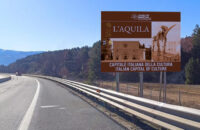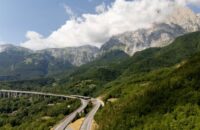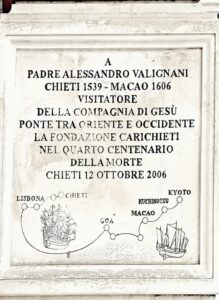 From Chieti to Kyoto, one way. This is how one could summarize with a slogan the life story of Father Alessandro Valignani (or Valignano, according to the custom of his time), who was born in Chieti on February 15, 1539, to one of the most conspicuous families of Chieti and died in the Far East in 1606, after having become thoroughly acquainted with the customs and traditions of the then mysterious Japan.
From Chieti to Kyoto, one way. This is how one could summarize with a slogan the life story of Father Alessandro Valignani (or Valignano, according to the custom of his time), who was born in Chieti on February 15, 1539, to one of the most conspicuous families of Chieti and died in the Far East in 1606, after having become thoroughly acquainted with the customs and traditions of the then mysterious Japan.
But Alessandro Valignani was much more than a Jesuit Father charged with directing a mission to distant lands. He was an entrepreneur, a diplomat, the author of one of the most modern and enlightening treatises on intercultural dialogue, a forerunner of principles that guide marketing today.
After spending his youth in Chieti, where he was made a canon in the cathedral of St. Justin by Pope Paul IV, who had been bishop of Chieti and a family friend, his thirst for knowledge led him to study in Padua and Rome, where he earned a doctorate in canon law. His brilliant mind and deep spirituality led him to embrace the Society of Jesus in 1566.
Missions to the East and Japan
In 1573, Father Alexander was sent as Visitator General of the East Indies by the Jesuits. He left Rome for Portugal, with a retinue of 41 Jesuits, to the Portuguese colony of Goa in India where, appointed provincial responsible, he stayed four years. In India he founded a printing press and reorganized the Indian missions with modern seminaries. He visited Jesuit missions in Malaysia and in Macau, a small Portuguese colony in China, where he later founded the Jesuit College of St. Paul, the first university in the Far East and a point of reference for the Society of Jesus in Asia.
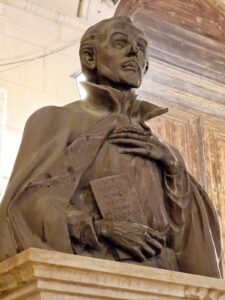 From here he embarked for Japan, where he arrived in 1579, managing to fit into the complex political climate of conflict between family clans, and won the trust of the feudal lord (daimyo) Ōmura “Bartholomew” Sumitada, the first Japanese nobleman to convert to Christianity.
From here he embarked for Japan, where he arrived in 1579, managing to fit into the complex political climate of conflict between family clans, and won the trust of the feudal lord (daimyo) Ōmura “Bartholomew” Sumitada, the first Japanese nobleman to convert to Christianity.
Under Valignano’s leadership, a large trading port was built in Nagasaki, at that time a simple fishing port, which became an important center of cultural and commercial exchange, especially for Chinese silk and Japanese silver, with a profit, for the merchants, of 70 percent, and a 5 percent recognized to the Society of Jesus. With these proceeds, the mission in Japan became the most prosperous in the entire East.
Father Alexander opened new seminaries and churches and established the first movable type printing press in Japan, in Kazusa, contributing to the spread of Western culture. Here he had the first grammar and vocabulary for translating Japanese published. He also organized the first Japanese ambassadorship to Europe, choosing four young Japanese seminarians from noble families to introduce customs and traditions to European courts. They visited Portugal and Spain, landing in Italy in 1585. Here they continued on to Florence, Pisa and Siena and finally arrived in Rome, where Pope Sixtus V granted them Roman citizenship and gave them the church of Santa Maria dell’Orto in Trastevere. This magnificent Baroque church, which has been a reference point for the Japanese community in Italy for centuries, houses a portrait of Giuliano Nakaura, one of the four ambassadors, martyred in Japan in 1633 and beatified in 2008, painted in 2009 by Japanese painter Kazuko Mimaki.
Few people remember him, but Father Alexander was also superior and teacher of Matteo Ricci, the great mathematician and evangelizer of China, now celebrated worldwide by books and conferences. It was Valignano who prepared him for his post and appointed him provincial superior of the new Province of China in 1604.
Thought on enculturation
In Japan Valignano developed a great admiration for the culture of that people and understood the importance of a respectful approach to local cultures. He promoted the learning of the Japanese language by missionaries and advocated the adaptation of Christian practices to Japanese customs. For this he is considered a pioneer of inculturation, a process of adapting the Christian message to different cultures without distorting it. He argued that missionaries should be thoroughly familiar with the language, customs and mentality of the peoples they evangelized. He was the author of a “Ceremonial for Missionaries in Japan,” a veritable manual of the concepts of “inculturation” and “adaptation,” in which he emphasized the importance of deepening knowledge of religious as well as artistic, linguistic and literary aspects of different cultures, as well as customs and traditions, resting on four cornerstones of behavior: authority, respect, love and confidence.
Valignano is said to have been a man of great charisma and diplomacy. During a meeting with the powerful warlord Oda Nobunaga, Father Alexander was able to impress him with his learning and eloquence, gaining his protection for Jesuit missions. Nobunaga donated land to build a seminary near Lake Biwa in Valignano, and the latter assigned Yasuke, who had followed the missionary to Japan from as far away as Mozambique, to the feudal lord as his bodyguard. Yasuke would be the first man of African descent to become a samurai. He has inspired novels and video games, and as of 2021 he is the protagonist of a Japanese anime television series.

On the trail of Father Alexander in Rome and Abruzzo
In the 16th and 17th centuries, the Jesuits played a crucial role in spreading Christianity and European culture around the world. They founded schools, universities and research centers, contributing to the development of the sciences and the arts.
To try to understand what the Jesuits represented for Western culture during Valignani’s centuries in Rome, the Church of St. Ignatius of Loyola and the Church of Jesus can be visited a few hundred meters away. In the former, consecrated to the founder of the religious order, one can admire Andrea Pozzo’s extraordinary frescoes of St. Ignatius in Glory among the four Continents then known. In the nearby Church of Jesus, you can also visit the St. Ignatius Rooms free of charge, a corridor frescoed by the same artist, with a particularly striking effect of optical illusion. Behind the church of St. Ignatius, in the Piazza del Collegio Romano, one can now visit the Wundermusaeum, on the site of the former Jesuit College, opened by Pope Gregory XIII in 1584, and where illustrious scholars from four centuries of history have passed through, from Clavius, to Galilei, to Kircher, to Boscovich, to Leibniz, to Secchi to the Nobel Prize winner for economics Modigliani . The former Roman College building now houses the Visconti High School, and the museum can be visited free of charge by appointment by contacting the person in charge.
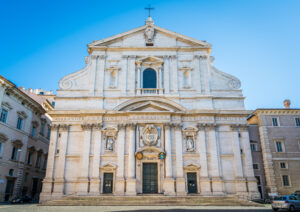
Chieti commemorates its illustrious fellow citizen with a bust, created for the 400th anniversary of his death by master Luciano Primavera in the new Piazza di San Giustino, reopened last summer. In his hometown Father Alexander advocated the building of a Jesuit college, which, however, was not established until 1628, twenty-two years after his death, thanks to the good offices of Giovanni Andrea and Ascanio, his brothers. The Jesuit church with attached college stood in Piazza Valignani. It was abandoned and then demolished from the foundations when the Jesuits, perceived as a threat by various European monarchies because of the cultural power and wealth they enjoyed, were driven out of the Kingdom of Naples. In its place in 1818, what is now one of Abruzzo’s most beautiful and celebrated theaters, the Teatro Marrucino, was built, while the building that housed the college now houses the Costantino Barbella Museum‘s collection of Abruzzo sculptures, paintings and crafts.




